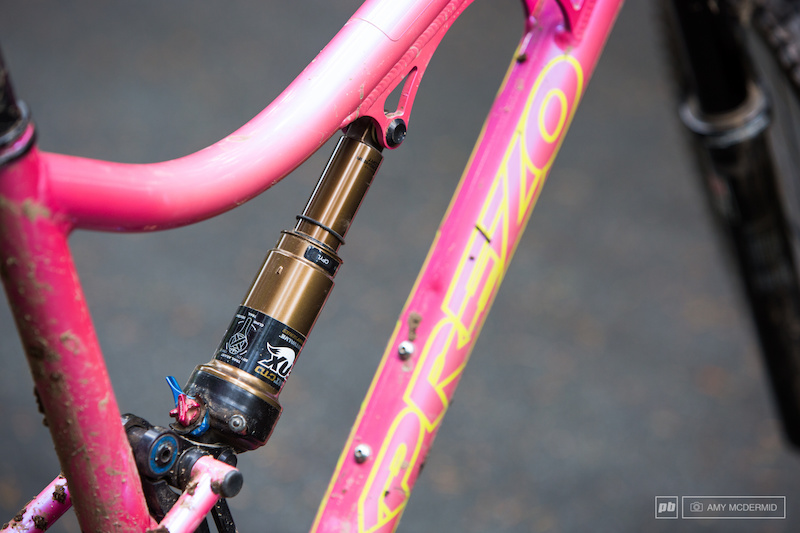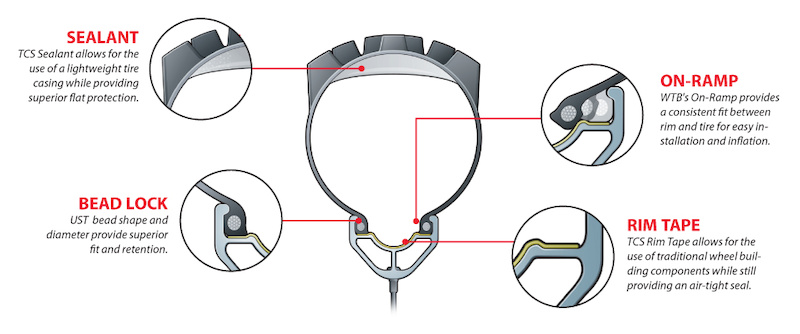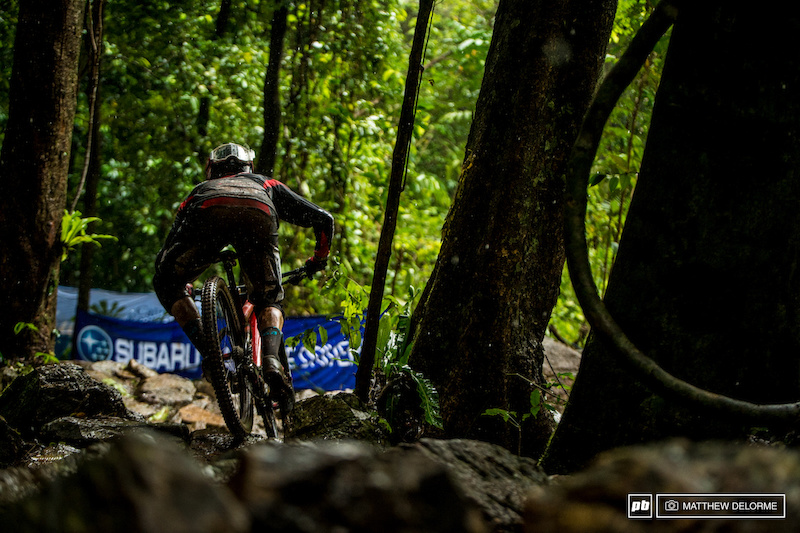Ask Pinkbike: Correct Shock Length, Tubeless for Gravity, A-Line Paralysis Tips, and Keeping the Bits Out of Your Goggles
Here at Pinkbike we get inundated with all kinds of questions, ranging from the basic "Can I have stickers" to more in-depth, soul searching types of queries like if you should pop the question or what to name your first child. Ask Pinkbike is an occasional column where we'll be hand picking and answering questions that have been keeping readers up at night, although we'll likely steer clear of those last two and keep it more tech oriented.
Shock Length Question
Question: Pinkbike user darwinws asked this question in the Mechanics' Lounge: I'd like to upgrade from the FOX DHX Air 5.0 shock on my bike but I'm having trouble finding something that fits. It has a 216mm eye-to-eye length, but most others that are close are 222mm long. Would using a shock that's 6mm longer affect the bike's geometry or cause other problems?
 | You're best to stick to the stock length shock on your bike. The longer shock will have a small effect on your bike's geometry - it will get slightly steeper if you run the same sag as the stock shock - but my bigger concern comes down to clearance issues. No, 6mm doesn't sound like much, but there are many places on a full-suspension bike where links or a swingarm can come extremely close to the frame, and engineers have designed the bike to within very tight standards. Putting on that longer shock could cause moving parts to come into contact with each other, which could lead to major damage. At the very least I would test fit the longer shock by installing it without the spring (or deflating it if it's an air shock) and pushing the bike through its travel to make sure that everything clears. It might not be an issue on some bikes but will be on others. - Mike Levy |

Some frames, such as Xprezo's Adhoc, have pretty tight clearances when it comes to its suspension linkage. A longer eye-to-eye shock wouldn't fit.
Tubeless for Technical Riding?
Question: Sshredder says: in a PM: I was reading a thread about tubeless tires. I like to ride trails that cause pinch flats. I like rock Gnar etc. I prefer to run 800-gram tires with about 25 to 30 psi to prevent pinch flats and let the fork do most of the absorbing. If I run tubeless, I would probably want to run thicker-wall tires at a lower psi. That negates any weight savings, but in theory, I will not get pinch flats and will have better traction. If I ride aggressively, I will burp the tires (I have read). Will running a higher psi stop this? If I run say, 25 psi in a tubeless system, will I notice an improvement in traction? Is it worth it for my style of riding? I would say that I ride fast, with plenty of mistakes on roots rocks and steep stuff. I live at the base of the North Shore.
 | Few DH pros run tubes, so that is as good an indication as any that tubeless tires can corner hard and not burp air or pinch flat. Almost no enduro racers run tubes as well, but it is worth noting that both groups use wide rims (26 to 30mm inner widths) to stabilize the tires laterally. Pinch flatting is caused by the shearing action of the tire carcass as an impact captures the tube between the folded tire carcass and the rim's flanges. Eliminating the tube eliminates pinch flats, but even with a tubeless arrangement, the possibility remains that an impact with a hard object can rupture the tire's sidewall beyond the sealant's ability to instigate an instant repair and you will flat in a similar manner. That said, That said, I'd go for tubeless. Use one-inch Gorilla tape to seal the rim, and Stan's is the best sealant and valve stem supplier. Keep the tires at 40 psi overnight after you mount them so the rubber glues itself to the rim walls (an old moto trick) and try dropping five psi from the pressure that you normally used when riding with tubes. Running tubeless will get you more traction everywhere, even if the tires are heavier, and your bike will roll faster. Both are facts. Keep one spare tube with you as a backup and you should be good to go. There are some technical tips worth considering for first-time tubeless folks. All tires have a pressure sweet spot that provides stable cornering and good traction, so experiment until you find the right combination. Most rims and tires can be converted to tubeless, but the obvious advice is to begin with a rim and tire combination that is stated to be "tubeless ready" or even better, "UST certified," so that the inner-rim profile and tire-bead construction will assist and not stymie your efforts to mount and inflate the tires. Most combinations intended for tubeless will air up with a floor-pump if you remove the valve core to increase the flow into the tire. Stubborn tires require a ready source of compressed air. In lieu of a compressor, a cheap air storage tank can be inflated with a floor-pump to get the job done. - RC |

While this image is a bit of an advertisement, WTB's tubelesss ready rim and tire combinations illustrate all of the important aspects of tubeless system systems: The inner rim profile encourages the bead to seat and seal. WTB uses the rectangular, certified UST bead and rim flange interface, and a latex-based sealant ensures that the tire carcass is initially sealed, and that the tire will be self healing.
Fingers Locking Up on Downhills?
Question: Roguee asks in the the Downhill Forum: My fingers are locking up a lot, I can't even enjoy rides any more because my fingers will be in agony on a two minute DH run. When I get to the bottom it takes about a minute for them to loosen up and then I can get the movement back. I was told I had my levers pointing down too low, so I moved them up (That actually worked for 2 or 3 runs and then the pain came back). Any suggestions on what I should do? I don't think I'm holding the bars too tightly and it's nothing to do with my suspension as it's happening on both bikes.
 | It sounds like you may have what I call A-Line hand, named after Whistler Bike Park's most famous trail. It's a common ailment at lift served resorts, where lap after lap of hard braking combined with the vibrations doled out by the miles of brake bumps can do a number on your hands, turning them into immovable claws by the end of the day. Adjusting your brake levers is a good starting point, but in addition to angle of the levers I'd also look at how far inboard the lever is. In most cases, there will need to be a gap in between where your grip ends and the lever body in order to achieve a comfortable position for one finger braking. I'd also recommend checking the lever reach (how far away the lever is from the bar). Having the levers positioned slightly closer to the bars can help relieve some of the stress on your hands. Once you have your brake lever position sorted out, take a look at the grips you're using. Thick or thin grips are a matter of personal preference, and it may take some experimenting before you find a set that works, but a comfortable grip can be a big help. Your local bike shop should be able to show you a few different options. Okay, your lever position is all set, you've got new, comfortable grips, but your hands still lock up - now what? It might be a matter of hand strength. You may not be holding on too tightly initially, but if your hands are getting fatigued it will force you to grip tighter and tighter with each run. There are a number of hand strengthening devices aimed at rock climbers that can work for cyclists as well. Don't overdo it, but work on steadily improving your strength until you can ride without pain. Of course, if the pain persists you should see a professional, a doctor or a physical therapist who can work with you to solve this issue. - Mike Kazimer |
Dirt Getting Into Goggles?
Question: Pinkbike user ZTSH asked this question in the Downhill Forum: A mate of mine was saying his goggles fit perfectly snug to his face, with no wind into his eyes. Yet he still gets mud in his eyes when riding. He says its just going through the foam. Is this true or is he making excuses?
 | A phenomenon that has discombobulated downhillers for decades. Clean goggles - check. Goggles fit flush with your face, no possible way for dirt to get inside the goggles - check. Begin downhill run, spot chunk of dirt floating around, dirt starts tickling your eyeballs, enter jump take-off/entrance in to a steep root-fest/muddy off-camber rock garden, lump of dirt gets lodged in eyeball. How is this even possible? The main cause of this dangerous distraction is putting your goggles on to the back of your helmet in between runs. It's easy for mud to flick on to the back of your helmet when riding, in the exact place you would put your goggles, the mud gets knocked into the goggles when you take them off, and the next thing you know one eye is searing and closed, depth perception is disarmed and you can only guess how many milliseconds it will take to collide with the tree you are on a collision course with. The solution? Put your goggles in the bag they were supplied with, or double up the strap and wear them on your forearm, and most importantly always give them a really good shake before you don them. - Paul Aston |

Placing goggles on the back of your helmet for your race-run is a sure-fire way to get mud in your eyes. Although Neko Mulally likes to make his own rules.
Have some unresolved tech questions? Jump in the Pinkbike Forum and we'll look to answer it for next time.
Author Info:
Must Read This Week
How to Watch the 2024 Mountain Bike World Cup [Update: Staylive Offering Access in New Zealand, South Africa & More]
60503 views
60503 views
[UPDATED] Final Elite XC Results & Overall Standings from the Mairiporã XC World Cup 2024
41491 views
41491 views
Sign Up for the Pinkbike Newsletter - All the Biggest, Most Interesting Stories in your Inbox
PB Newsletter Signup



i.ytimg.com/vi/HW0ayzYHKYY/hqdefault.jpg
Into this!!
31.media.tumblr.com/tumblr_l5etd5kDIY1qaqps8o1_500.png
This is simply not true. A huge number of enduro and dh pros were on 23mm inside width rims last year. Why? Because that is the rim width that most tire designers are working around!
While SB8 are not officialy tubeless ready, the man from KENDA told me to try it with the Orange sealant.
Also there are a tubeless-conv. kits that convert any tires/rims to tubeless system like Stan's or Joe's Sealant Conversion Kit on ebay.
That kits provide 2 molded rubber strips with integrated valves weighting 70 grams each( and other stuff.)
So, guys, did someone tried Kenda SB8 2.35" tubeless with some sealants/kits?
Is it necessarily to use that molded rubber strips(70grams!!!) or Gorilla type is enough ?
Is it enough only 1 wrap of gorilla tape ?
@ whitebullit
If you worried about that little added weight on a DH bike then yes I can agree with you.
But I did not mentioned DH bike.
My bike is at most for freeride with these wheels and current fork.
I mentioned Kenda SB8, they are not very DH, isn't it ?
And they are light: 120tpi 26x2.35" 680gramm
I like them because of fast rolling, pattern, lightweight and the price.
That's why I got them.
"worry about getting the tires seated correctly"
That's one of the reasons I asked my questions.
But I also consider the weight savings. Just because if the weight can be reduced then I will at least try to do it (without crazyness of course). Especially if that weight is rotational.
"id rather have a little extra weight and not have to worry all the time about getting a flat"
That's another reason of my asking and this article.
There are a tubes of just 100g weight. 70g molded rubber strips vs 100g tubes....
Seems they are thin for rough staff but if not to go rough it's ok and there is no that tubeless hassle.
Also I like high preassure in my tires, usually ~3.5bars
@wydopen
Oh yeah, thanks! Now I'm full enthusiasm!
What is your weigth ? I'm ~85kg
The guy who solves this issue deserves the physics nobel prize.
I found that in my newbness to dialing in suspension, I had too much compression and not enough rebound. Getting the rebound on my fork set up so it was slow enough not to pogo over big chatter (rocky trails) helped immensely. I just set it and forget it, so it works for the majority of my riding. Same with the compression, I get it close to where I want it and adapt from there, with plus or minus a few clicks as needed. Now I can ride for a few hours, until I'm pretty much spent, and no outrageous pain in the wrists and hands.
Bad setup or poor performing forks (forks in need of a rebuild) lead to GI Joe hand. Make sure your forks are running smooth through all its millimeters and setup properly for how you ride. If you ride lots getting the forks serviced a minimum of once a season works wonders - even if you think they don't need the love.
No one has said to let the bars dance in your hands.
Grip strength is not the answer to this. I started riding the park as a powerlifter with a mother f*cking kung-fu grip that was brought to it's knee's as a beginner years ago. As in, JesusMotherChristMyHandsAreF@ckingBusted, I'll-pay-you-money-to-fix-this bad.
Relax and let the bars move in your cupped hands and keep the weight on your feet for the majority of the lap and you will never have hand problems again.
Before you know it you'll be riding like Remy.
In my mind, it's more dangerous than something too long: you can change the angle of force at full compression on a shock mount doing this, which is less concerning at the top of the travel, but could be catastrophic in a hard bottom out: you might be loading welds instead of the mount.
Broadly, though, bikes are engineered to pedal well at certain point in the stroke, with a certain size chainring. you can make some bikes feel like crap just by putting the wrong size chainring on them. I'd feel better about trying it on a DH bike than a trail bike, & when I was considering doing something similar, I was going to stick with the same eye to eye, & just reduce the stroke.
After all, think about it: if you change the EtE & stroke by the same amount, if a 650b wheel is hitting the seat tube with the original shock, it'll hit the seat tube with the new one. So you have to shorten the stroke more than the EtE. Now you've magnified how much you're reducing the travel, because you're losing some by shortening the EtE(bike sits lower in the travel) & then losing some more by shortening the stroke(bike doesn't move as far through the travel before bottoming out.)
Not sure what you mean by the wheel not contacting anywhere without a shock... is the frame contacting the frame, or binding at a pivot? something has to stop it from moving any farther.
When I switched to XTs or other brakes known for modulation, I find that my hands don't get anywhere near as tired as before. You have a little more range for braking force, and it doesn't require as much force just to slow down a bit versus hard braking. I went from cramping within a few hours, to all day lift runs wondering why (but thankful) my hands and forearms weren't sore.
My arm pump drastically lowered after some months of regular rock climbing.
Moreover, that's fun and it pairs well with biking on a well planned trip.
try it. its true. believe me.
Also, you're the one that's confused about damping. The more damping in a fork, the less work it does, because damping DAMPENS the work. Try setting your rebound damping and compression damping to 100%. It'll do much less work than a well tuned one. Put the adjustments at 0% and it'll be a pogo stick (but do much more work. I'm not saying this is better, just illustrating how damping affects suspension performance)
after i wrote those things you still think you are educating me by explaining about packing up?? who's patronizing who? Ive literally been rebuilding and tuning DH forks since you were 7 years old, believe me i have a firm grasp of the topic and don't need help there...
you are still backwards and confused about the meaning of damping. not that i give a shit what you know or don't, i was just trying to be helpful to those who would benefit from reading the info cause i used to suffer from the same ignorance til i learned better. call any trusted suspension expert you like and try to get them to agree to your explanation of damping, ill bet money they will say what i have, you don't have to take it from me. happy trails in any case
i read my 2 sentences again, nothing to report, they are still spot on. call Fox, or Rockshox, or any bike shop in the world that does fork work, and have them tell you the exact same thing, I've done all i can here
I have been roasted and burnt by big mouths UST haters for well over a decade now. Before that I used Slime.
I have been UST via crossmax sx's and UST tires since 2002. Only twice have I had a flat caused by a large hole at least a 1/4 inch or more. Only once did I have to walk cause I could not fill the hole with the right size stick. Been using Hans Dampf and other Shwalbes and a few maxxis for over 4 years with zero issues.
My derailleur is always snapping forward when I want to pedal in rough stuff. It's like loosing the resistance of the chain for a split second and I almost crashed a few times because of this!
I have no idea whats going on there and my local bikeshops have no idea about bikes actually...
I hope it helps. Had me pretty confused for a while trying to fix it, wound up replacing most of the drivetrain before I got the issue fixed.
I replaced my chain and my cassette about 9 months ago. Everything worked fine for a few weeks and then, all of a sudden, the problem came back!
So I'm not sure if replacing the cassette and chain would help. I also got a new derailleur last September, because i smashed mine into pieces (don't ask how^^) and the same problem happend after a few rides.
RC I don't understand. We'll assume similar weights running one's wheelset with tubes vs no tubes because of the heavier tires you mentioned. We're also dropping five PSI without tubes. Of the two facts you mention, I agree with the first one, because the lower pressure will give you a larger contact patch and more traction. The second one seems to contradict this. How is the bike gonna roll faster? Seems to me, there'd be more rolling resistance, and the bike would roll slower. Whats the dealio, yo?
I found that the vent openings in my helmet (giro remedy) would let small peices of dirt or decomposed granite in, they would then sit on top of the seal of my goggles and after harder hits that jostled the helmet up and down a bit on my head, the rocks would make it past the seal.
Solution, helmets with mesh over the vents.
can anyone verify this? I think I always saw a tube when a DH pro lost his tire because of a flat.